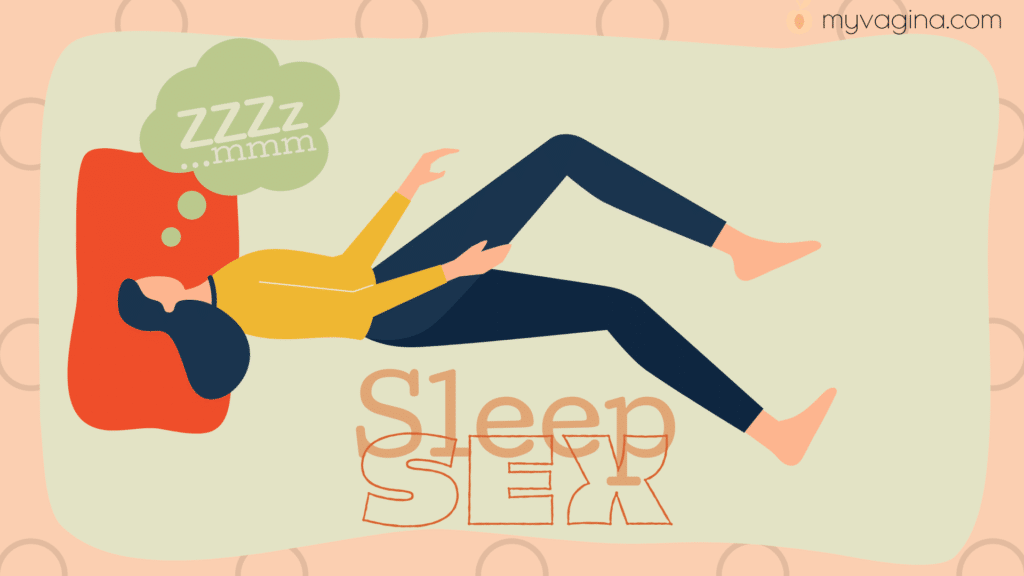A sexsomniac is a term used to describe someone who has a sleep disorder, in which a person unconsciously engages in sexual activity1. This includes moaning in a sexual way, to masturbating, to full intercourse.
When they wake up, a sexsomniac has no recollection of what’s gone on in their sleep. The sexual behaviour can be very aggressive, and even violent.
Who gets sexsomnia?
Sexsomnia is a type of parasomnia, like sleepwalking, sleep eating, or night terrors. It is estimated that around one in 10 people is affected by these sleep disorders.
In one study1, about four per cent of women who suffer from parasomnias reported sexual behaviours in their sleep, including masturbation2.
Men can be insomniacs too, with another study looking at what we do while we’re asleep, and how that differs by (cis) gender. Men commonly engage in fondling and intercourse with females, while women almost exclusively engaged in masturbation and sexual vocalisations.
Women report they’ve been told by partners that they are much more aggressive when they’re sleep-sexing, initiating things that would normally be well out of their comfort zone. This can cause some embarrassment.
Why does sexsomnia occur?
The question is, is this some kind of deep-seated desire floating out while we’re asleep? It seems not. Sleep is complicated, with several stages involved that affect various parts of the brain and body.
Sexsomnia occurs in stage 3 non-rapid eye movement (NREM) sleep, where the prefrontal cortex is inactive1. This part of our brain controls rational thought, decision-making, morality, and other parts of our ‘mind’ that may inhibit our behaviour in real life.
During NREM sleep, the body is not paralysed as it is during rapid eye movement (REM) sleep. If you are partially woken during stage 3 sleep, the sleep walking, eating, and talking may occur.
The body has nobody being the captain of the ship (prefrontal cortex), so the body just does whatever it likes, satiating its needs as it sees fit. That may include getting it on, eating, or feeling safe.
Sexsomniacs are likely to have other sleep issues such as nightmares, restless leg syndrome, or sleep apnoea3.
Treatment for sexsomniacs
Treating the underlying sleep disorder is key to curing sexsomnia, with one study into sleep disorders successfully treating 10 people out of 11 of sexsomnia. The main problem remains sleep, not being a sex-crazed maniac.
The legal ramifications of sexsomnia4–7
People who are awake do not have the same level of legal responsibility, since sexsomnia is a legitimate sleep disorder with laws that exist to support legal defences based on when we are not in control of our actions (automatism)4,5.
The legal defence of automatism has two varieties, with for example twitches or seizures being one, and being in a blackout-type state (semi-fugue state). Sexsomnia could fit into either category – being a result of a seizure or a sleep disorder.
But, having sex with someone while you’re asleep, and maybe they’re asleep, is tricky business. Criminal actions such as sexual assault or rape don’t go away because you were asleep, and a court will weigh the evidence appropriately to determine whether the criminal actions were involuntary.
This is extra tricky when the sexual behaviour is directed at a less forgiving party, such as a child. Sexsomnia has been used as a defence in some cases, with an example being a man who was accused of molesting his step-daughter.
He used the sexsomnia excuse, however, the court found that because he positioned her pillows and opened and closed the door to her room meant that he had higher brain functions going on than would be present in sexsomnia.
Typically, sexsomniacs don’t leave the bed. If you can walk and open a door, you do not have sexsomnia, but something else.
References
- 1.Schenck CH, Arnulf I, Mahowald MW. Sleep and Sex: What Can Go Wrong? A Review of the Literature on Sleep Related Disorders and Abnormal Sexual Behaviors and Experiences. Sleep. Published online June 2007:683-702. doi:10.1093/sleep/30.6.683
- 2.Toscanini A, Marques J, Hasan R, Schenck C. Sexsomnia: case based classification and discussion of psychosocial implications. Sleep Sci. 2021;14(2):175-180. doi:10.5935/1984-0063.20200057
- 3.Soca R, Keenan JC, Schenck CH. Parasomnia Overlap Disorder with Sexual Behaviors during Sleep in a Patient with Obstructive Sleep Apnea. Journal of Clinical Sleep Medicine. Published online August 15, 2016:1189-1191. doi:10.5664/jcsm.6066
- 4.Organ A, Fedoroff JP. Sexsomnia: Sleep Sex Research and Its Legal Implications. Curr Psychiatry Rep. Published online March 21, 2015. doi:10.1007/s11920-015-0568-y
- 5.Ingravallo F, Poli F, Gilmore EV, et al. Sleep-Related Violence and Sexual Behavior in Sleep: A Systematic Review of Medical-Legal Case Reports. Journal of Clinical Sleep Medicine. Published online August 15, 2014:927-935. doi:10.5664/jcsm.3976
- 6.Zaharna, et al M. Sexual behavior during sleep: convenient alibi or parasomnia; “sexsomnia” disrupts sleep, threatens relationships, and has forensic implications. Current Psychiatry (Vol. 7, Issue 7). Published 2008. link.gale.com/apps/doc/A181861015/AONE?u=anon~5721e4cb&sid=googleScholar&xid=9b3b8090
- 7.Watson C, Pressman MR, Weiss KJ. Sleep Disorders and Criminal Responsibility. Psychiatric Expert Testimony: Emerging Applications. Published online January 2015:102-121. doi:10.1093/med/9780199346592.003.0007
The most comprehensive vaginal microbiome test you can take at home, brought to you by world-leading vaginal microbiome scientists at Juno Bio.
Unique, comprehensive BV, AV and 'mystery bad vag' treatment guide, one-of-a-kind system, with effective, innovative treatments.
Promote and support a protective vaginal microbiome with tailored probiotic species.






